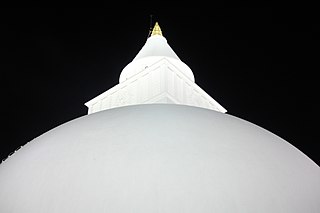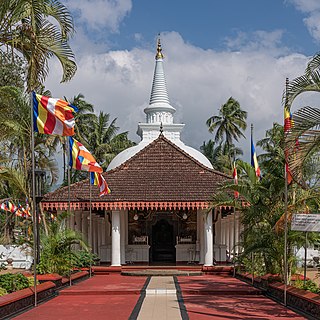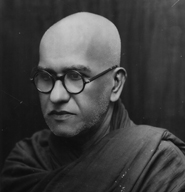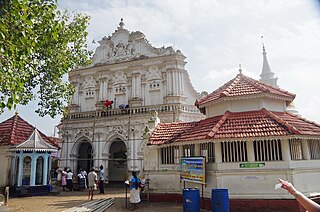Rāmañña Nikāya was one of the three major Buddhist orders in Sri Lanka. It was founded in 1864 when Ambagahawatte Saranankara, returned to Sri Lanka after being ordained by the Neyyadhamma Munivara Sangharaja of Ratnapunna Vihara in Burma. It was one of three Sri Lankan orthodox Buddhist monastic orders, along with Siam Nikaya and Amarapura Nikaya. On 16 August 2019, the Amarapura and Rammana Nikaya were unified as the Amarapura–Rāmañña Nikāya, making it the largest Buddhist fraternity in Sri Lanka.

Kiri Vehera is an ancient stupa situated in Kataragama, Sri Lanka. This stupa probably dates back to the 3rd century BC and is believed to have been built by King Mahanaga brother of king Devanampiyatissa; a regional ruler of Kataragama area. One of the most popular Buddhist pilgrimage sites in the country, Kiri Vehera is among the Solosmasthana, the 16 most sacred Buddhist pilgrimage sites of ancient Sri Lanka. This stupa which is 95 ft. in height with a circumference of 280 ft. is located 800 m North to the famous Ruhunu Maha Kataragama Devalaya. Venerable Kobawaka Dhamminda Thera is the present Chief Prelate of Kirivehera Rajamaha Viharaya.

The Kelaniya Raja Maha Vihara or Kelaniya Temple is a Buddhist temple in Kelaniya, Sri Lanka. It is located 11 km (6.8 mi) north-east of Colombo. The current chief incumbent is Venerable Professor Kollupitiye Mahinda Sangharakkhitha Thera.

The Tissamaharama Raja Maha Vihara is an ancient Buddhist temple in Tissamaharama, Southern Province of Sri Lanka. It was one of the four major Buddhist monasteries established in Sri Lanka, after the arrival of Arhant Mahinda Thera to the country. The site of the Tissamaharama Raja Maha Vihara was consecrated by Buddha himself, who spent some time in meditation there with 500 arhats, during his third visit to the island. Tissamaharama monastery had been recognized as a pre-eminent Buddhist educational center of the southern Sri Lanka from the 3rd century B.C. to the 11th century A.D. The Tissamaharama Dagoba which is situated in the premises of the monastery is one of the largest stupas in Sri Lanka. The present chief incumbent of Tissamaharama Raja Maha Vihara is Ven. Devalegama Dhammasena Nayaka Thera.

Muthiyangana Raja Maha Vihara is an ancient Buddhist temple located in the middle of Badulla town in the Badulla District of Uva Province in Sri Lanka.

Upulvan, also known as Vishnu is a guardian deity of Sri Lanka. Sri Lankan Buddhists believe him also as a protector of the Buddhism in the country. The name Upulvan depicts his body colour which means "blue water lily coloured". The cult of Upulvan started during the medieval period in Sri Lanka. According to the local lore and legend, Upulvan is the god whom the Buddha entrusted with the guardianship of Sri Lanka and Buddha Śāsana of the country.

Seruwawila Mangala Raja Maha Vihara is an ancient Buddhist temple in Trincomalee district in Eastern Province, which is among the sixteen or seventeen holiest Buddhist shrines (Solosmasthana) in Sri Lanka.
Dambagasare Sri Sumedhankara Thero was a Buddhist monk from Sri Lanka who re-discovered the Seruvila Mangala Raja Maha Viharaya temple in 1922.

Ridi Viharaya or Silver Temple is a 2nd-century BCE Theravada Buddhist temple in the village of Ridigama, Sri Lanka. Built during the reign of Dutthagamani of Anuradhapura, the temple is considered as the place where the silver ore, which provided silver to complete Ruwanwelisaya; one of the largest stupa in Sri Lanka, was discovered. According to the chronicles Mahavamsa and Thupavamsa, the Ridi Viharaya complex was built in gratitude for helping him cherish his dream of completing Ruwanwelisaya.

Weliwita Asaranasarana Sri Saranankara Sangharaja Thero or popularly Weliwita Sri Saranankara Thero was a Buddhist monk, who was the last Sangharaja of Sri Lanka. He was the pioneer in the revival of Buddhism in Sri Lanka, after the decline of the religion in the 17th and 18th centuries. Saranankara Thero was bestowed with the a title by king Kirthi Sri Rajasinghe in 1753, the same year he received the Upasampada and re-established the Upasampada in Sri Lanka with the help of Mahasangha in Siam. He is also credited with the establishment of Silvath Samagama, a union of monks who lived in accordance with the Buddhist monastic discipline.

Bellanwila Rajamaha Viharaya is a Buddhist temple situated in Bellanwila, Colombo District, Sri Lanka. Located around 12 km south to the Colombo city, near Dehiwala - Maharagama road, the temple attracts hundreds of devotees daily and is famous for its annual Esala Perehera festival which usually takes place in the month of August or September. One of the most venerated Buddhist temples in Sri Lanka, many devotees flock to worship the sacred Bo tree of Bellanwila Rajamaha Vihara, which is considered to be one of the first offshoots of Jaya Sri Maha Bodhi in Anuradhapura, Sri Lanka. The present chief incumbent of Bellanwila Rajamaha Vihara is Ven. Dr. Bellanwila Dhammaratana Nayaka Thera.

Magul Maha Viharaya is an ancient Buddhist temple situated in Lahugala, Ampara District of Sri Lanka. The temple lies on the northern edge of the Lahugala National Park, about 22 km off from Siyambalanduwa town and about 11 km off Pottuvil town. Lahugala has been part of the Kingdom of Ruhuna in ancient Sri Lanka. The ruins of Magul Maha Vihara are one of the major tourist attractions of the Eastern province. This temple is also an archaeologically protected monument of the country.

Kalutara Bodhiya is a Bodhi tree located in Kalutara, Western Province of Sri Lanka. Situated on the Galle Colombo main road, by the side of Kalu River just south to the Kalutara city, it is believed to be one of the 32 saplings of the Jaya Sri Maha Bodhi in Anuradhapura, Sri Lanka. A Buddhist temple Kalutara Viharaya and a modern Stupa, Kalutara Chaitya are located in close proximity to this sacred fig. One of the most venerated religious place in Sri Lanka, hundreds of Buddhists and foreign tourists visit this religious place daily.

Palane Vajiragnana Thero was a Sri Lankan (Sinhala) scholar Buddhist monk, who founded the Siri Vajiraramaya temple in Bambalapitiya, Sri Lanka. He was also the Maha Nayaka (head) of Amarapura Sri Dharmarakshita sect for 37 years from August 5, 1918 until his death in 1955.

Gadaladenyia Vihara is an ancient Buddhist temple situated in Pilimathalawa, Kandy, Sri Lanka. It is located on Gadaladenyia Road (B116), just up from the Gadaladeniya junction of the Colombo - Kandy Road (A1), approximately 12.5 km (7.8 mi) to the west of Kandy and 3 km (1.9 mi) from the ancient buddhist temple, Lankatilaka Vihara. It is considered one of the largest rock temples in Sri Lanka.

Kande Vihara is a major Buddhist temple in Kalutara District, Sri Lanka. The temple has got its name 'Kande vihara' as it is built on top of a hill located near to Aluthgama town. The temple has been formally recognised by the Government as an archaeological site in Sri Lanka.

Mahindarama Buddhist Temple is a Sri Lankan temple situated in Jalan Kampar of George Town of Penang in Malaysia. It is the sole and the oldest Malaysian Sri Lankan temple in the state which is also one of the few temples in Malaysia where the Buddha's relics are stored. The temple became a focal point for the Candle Lighting Day and the annual Wesak festival within the city suburb.

Malwathu Maha Viharaya is a Buddhist monastery located in Kandy, Sri Lanka. It is the headquarters of the Malwatta chapter of Siyam Nikaya and one of the two Buddhist monasteries that holds the custodianship of sacred tooth relic of Buddha kept in Sri Dalada Maligawa, Kandy. The chief incumbent of the Malwathu Maha Viharaya is the Mahanayaka thero of Malwatta chapter of Siyam nikaya, a leading Buddhist monastic fraternity in Sri Lanka. The present chief incumbent of Malwathu Maha Viharaya is Thibbatuwawe Sri Siddhartha Sumangala Thero.
Asgiri Maha Viharaya is a Buddhist monastery located in Kandy, Sri Lanka. It is the headquarters of the Asgiriya chapter of Siyam Nikaya, one of the two Buddhist monasteries that holds the custodianship of sacred tooth relic of Buddha kept in Sri Dalada Maligawa, Kandy. The chief incumbent of the Asgiri Maha Viharaya is the Mahanayaka thero of Asgiri chapter of Siyam nikaya, a leading Buddhist monastic fraternity in Sri Lanka. The present chief incumbent of Asgiri Maha Viharaya is Warakagoda Sri Gnanarathana Thero. Asgiri Maha Vihara traces its origin from the Wanavasi sect of the Dimbulagala forest monastery of Polonnaruva. Currently, 565 Buddhist temples in Sri Lanka function under Asgiri Viharaya of Kandy.















